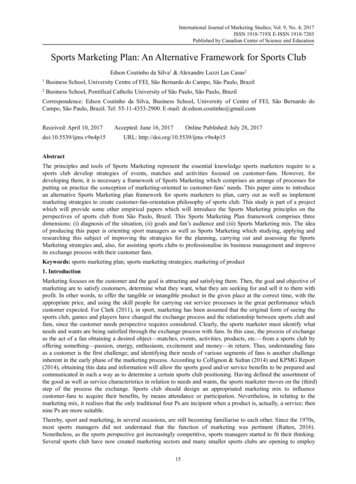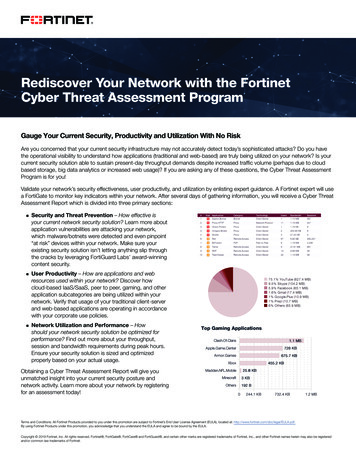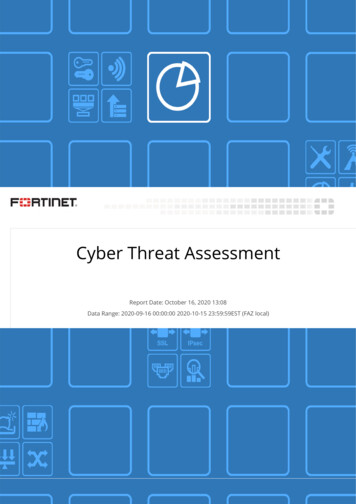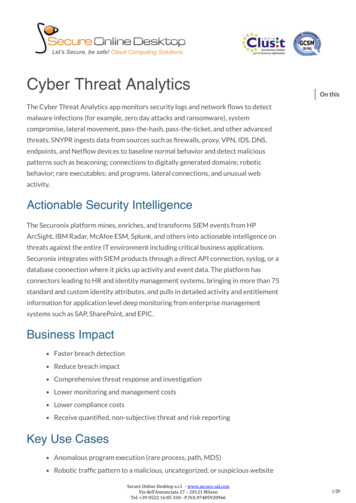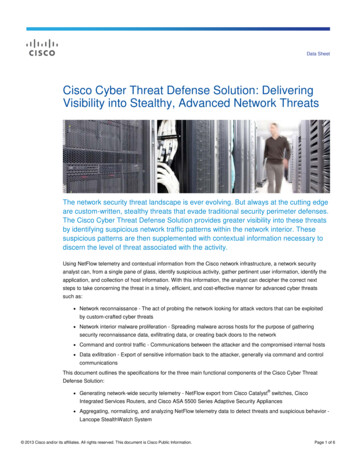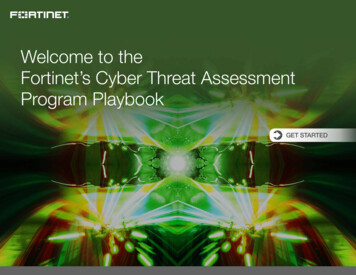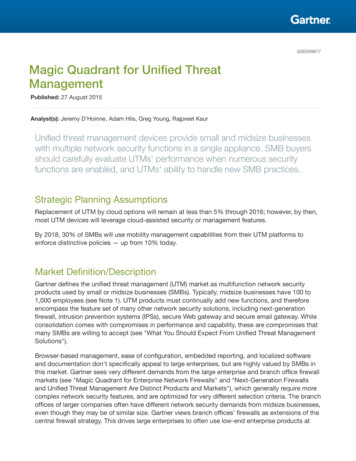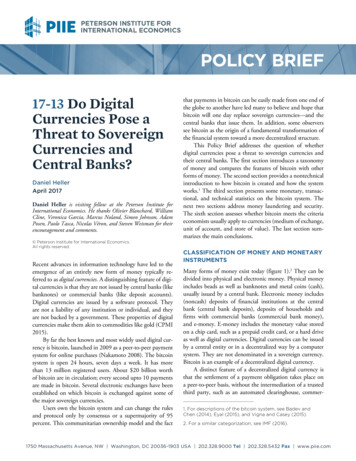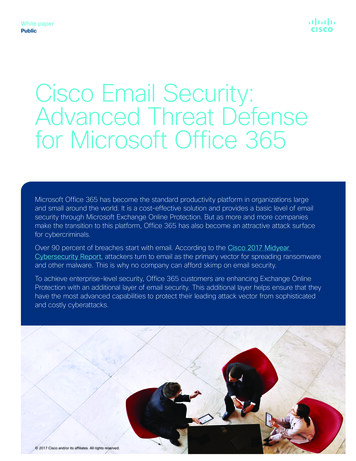
Transcription
The Cyber Threat toSports OrganisationsEnsuring fair play onlineNational Cyber Security Centre
The Cyber Threat to Sports OrganisationsContents4Forewords6Introduction5The Cyber Threat to Sports OrganisationsExecutive summarySource of statisticsHow digitally reliant is sport?8Threat overviewNature of the threatNation-state involvementMajor events10Attack trendsTrend 1: Business Email Compromise (BEC)Trend 2: Cyber-enabled fraudTrend 3: Ransomware20Venue securityAttack opportunitiesImplementation of key technical controlsVenue security: mitigation23Risk management & industry trendsHow important is cyber security and whoprovides leadership?What is driving cyber risk management?Risk management guidance2National Cyber Security CentreNational Cyber Security Centre3
The Cyber Threat to Sports OrganisationsThe Cyber Threat to Sports OrganisationsExecutive SummaryForewords Sport is central to British life. It provides massivehealth, social and economic benefits to thenation, contributing billions of pounds to theUK economy each year. This power and profilemake the sector a target for criminals andother cyber attackers. The primary cyber threat comes from cybercriminals with a financial motive. Criminalattacks typically take advantage of poorimplementation of technical controls andnormal human traits such as trust andineffective password policies. Cyber security is regarded as an importantissue by sports organisations. Almost all thosesurveyed reviewed cyber security measures inpreparation for compliance with the GeneralData Protection Regulation (GDPR). Statistically,this approach appears to have been successfulat preventing mass data breaches. There have been a small number ofHostile Nation-state attacks against sportsorganisations; typically, these attacks haveexploited the same vulnerabilities usedby criminals. However, cyber attacks against sportsorganisations are very common, with 70% ofthose surveyed experiencing at least one attackper annum. This is significantly higher than theaverage across UK business.Sports organisations are reliant on IT andtechnology to manage their office functions and,increasingly, their security systems at venues. Asdetailed in this report, cyber attacks can have awide-range of impacts; from multi-million poundfraud to the loss of sensitive personal data. TheNCSC is not just here to look after the IT systemsof the UK government. We are committed tosupporting the sports sector and we encourageyou all to implement the guidance outlined inthis report.Ciaran Martin - Chief Executive Officer, NCSCCyber security is of ever-increasing importanceto sports organisations, from grass roots clubsholding personal data through to nationalorganisations hosting and participating in majorinternational sporting events. Losing access todata, IT or technology can have a significantimpact on sports organisations resulting in databreaches, fraudulent loss of funds and disruptionto event delivery. Improving cyber security acrossthe sports sector is critical. The British OlympicAssociation sees this report as a crucial first step,helping sports organisations to better understandthe threat and highlighting practical steps thatorganisations should take to improve cybersecurity practices.Rt Hon Sir Hugh Robertson, Chair of the BritishOlympic Association (BOA) The most common outcome of cyber attacksis unauthorised access to email accounts(Business Email Compromise) leading tofraud. Ransomware is also a significant issuein the sector.The survey highlights the following key areas for sports organisations to review:Email securityGood email technical controls are not routinely applied in the sports sector.Implementing measures such as anti-spoofing and multi-factor authentication cansignificantly reduce your cyber risk.Staff empowermentUnder half of organisations provide staff training. Staff are an important line of defenceand it is essential to encourage people to report any suspicious activity they spot.Cyber risk managementSports organisations are complicated. Survey results indicate that organisations wouldbenefit from a holistic approach to Risk Management, looking beyond compliance(e.g. beyond GDPR) to ensure all cyber risks are considered across the IT estate.4National Cyber Security CentreNational Cyber Security Centre5
The Cyber Threat to Sports OrganisationsThe Cyber Threat to Sports OrganisationsIntroductionSport is central to British life. It provides massivehealth, social and economic benefits to the nation,contributing to over 37 billion to the UK economyeach year.Unfortunately, this financial power makesthe sector a target for criminals and othercyber attackers.This report is designed to demystify the cyberthreat to sports organisations by highlighting thecyber security issues that affect the sector on adaily basis: business email compromise, digitalfraud, and venue security.Along with descriptions of these commonattack types, we include some statistics on theiroccurrence and suggestions for measureswhich will stop the vast majority of these attacks- or at least reduce their impact.Sports organisations of all shapes and sizeswill find this guide useful. From local clubs tonational federations.Source of statisticsThe statistics contained in the report are primarilydrawn from an Ipsos MORI survey, commissionedby the National Cyber Security Centre (NCSC).The survey explored experiences of cyberincidents and breaches, attitudes towards cybersecurity and its relation to physical security.All fieldwork was conducted in the spring of 2019.Sports organisations conduct a lot of activityonline and the vast majority hold personalinformation on customers/employeesIpsos MORI completed telephone surveys with57 sporting organisations. This sample includedsporting bodies and specific clubs, from sportssuch as football, rugby, tennis, cricket andathletics. This may seem a small sample sizebut, nonetheless, we feel it is sufficient to illustratesome trends and common challenges faced bythis sector.Eight respondents also completed in-depth,telephone interviews which lasted approximately1 hour. The qualitative sample was made up of amixture of sporting bodies and associations.Which of the following if any does your organisation currently have or use?A website or blog95%Personal information about your (customers/beneficiaries/service users) held electronically95%Personal information about your employeesheld electronically95%How digitally reliant is sport?Email addresses for your organisation or itsemployees or volunteersLike most of the UK economy, sport is highlyreliant on digital technology. Sport is playedin large venues with networked securitysystems controlling essential functions such asturnstiles and security cameras. Sports clubsand organisations hold a significant amount ofsensitive personal data and process millions offinancial transactions every yearInternal online business systemsThe Ipsos MORI report revealed that almost allsports organisations have a website, social mediaaccount, and hold digital records containingpersonal information about customers, staffand volunteers. Over 80% of respondents hadonline business systems and offered customersthe opportunity to make bookings, payments orpurchases via the internet.96%Accounts or pages on social media sites93%88%The ability for customers to order, book or payfor services online82%A systems/database for sharing confidential,medIcal or performance data (players or athletes)77%An online bank account your organisation or yourclients pay into74%40%An online sharing platform (eg Strava)Which of the following if any does your organisation currently have or use?100%89%70%63%30%Non-work approvedpersonal devices6National Cyber Security CentreWork approvedpersonal devicesWorktabletsWork smart phones ormobile phonesWork desktopsor laptopsNational Cyber Security Centre7
The Cyber Threat to Sports OrganisationsThe Cyber Threat to Sports OrganisationsThreat OverviewAt least70%of sports organisationshave experienced a cyberincident or breachNCSC research indicates that the cyber threat tothe UK sports sector is significant.At least 70% of the sports organisations wesurveyed have experienced at least one cyberincident or harmful cyber activity. This comparesto 32% across general UK business, according tothe DCMS annual breaches survey.Around 30% of incidents resulted in directfinancial damage to the victims, with costsvarying considerably from under 500 throughto over 100,000 per incident. The average costwas more than 10,000 per incident.Beyond direct financial costs, 41% of breachesor attacks resulted in new measures being putin place to prevent further incidents.30%of organisations recordedover 5 incidents in thelast 12 monthsNational Cyber Security Centre30%of these incidents causeddirect financial damage,averaging 10,000 perincidentThe biggest singleloss was over 4m(excluded fromaverages)Nature of the threatNation-state involvementMajor eventsThe primary cyber threat to sports organisationscomes from cyber criminals with a financialmotive. Survey data, quantitative research andthe NCSC’s own incident data suggests thatalmost all criminal attacks are conducted usingcommonly available tools and techniques whichdon't need a lot of technical knowledge to beeffective. These include phishing, passwordspraying and credential stuffing.Broadly speaking, the NCSC assesses that thereis a remote chance of nation-states targetingthe sport sector. However, there have been asmall number of highly targeted incidents wherenation-states have conducted cyber attacksagainst sports organisations.We assess that organisations which host majorsporting events face a higher cyber threat thanthe industry average. The 2018 Winter Olympicsin Pyeongchang were hit with an advanced andwide-ranging series of cyber attacks, reportedlycausing disruption to the opening ceremonyand the event's website. These activities werealmost certainly conducted by a nation-state,with intent to disrupt the games.These low level attacks often take advantageof poorly-implemented security controls.For instance, ineffective password policiesand known software bugs that aren't patched.They also exploit normal human traits such astrust, in order to gain unauthorised access toaccounts or business systems. The outcomeof these 'commodity' attacks varies, but oftenresults in Business Email Compromise (BEC) orthe delivery of malware.In most cases, attacks are not targeted, sportorganisations just happen to be victims of masscampaigns. However, major losses have beenexperienced by sports organisations as a result ofbespoke attacks, where criminals have harvestedinformation before undertaking fraudulentfinancial transactions.8ApproximatelyThe most high profile attacks were conductedby Russian Military Intelligence (GRU) against theWorld Anti-Doping Agency, in August 2016. The GRUstole confidential medical files from WADA’sAnti-Doping Administration and ManagementSystem, then leaked sensitive information ontothe internet.The WADA hack was part of a wider campaign ofmalicious activity against sporting bodies likelyconducted in retaliation for its athletes beingbanned from competing under the Russian flag.Consequently, we assess that the Russian threatto sports organisations is focussed on a smallsubgroup of organisations that hold, or haveaccess to, sensitive athlete data. The likelihoodof this threat materialising will increase if Russia’srelationship with host countries or sportinginstitutions deteriorates in the run up to a majorsporting event.It should be noted that major sportingevents also face a heightened criminal threat.Quantitative research indicates that majorevents are targeted by cyber-enabled crime,such as 'spear phishing', and cyber-dependentcrimes such as ticketing scams.National Cyber Security Centre9
The Cyber Threat to Sports OrganisationsThe Cyber Threat to Sports OrganisationsAttack trendsTrend 1:Business EmailCompromise (BEC)Attack types definedPhishingPhishing describes a type of social engineeringwhere attackers trick users to 'do the wrongthing', such as disclosing information or clickinga bad link. Phishing can be conducted via a textmessage, social media, or by phone, but thesedays most people use the term 'phishing' todescribe attacks that arrive by email. Email is anideal delivery method for phishing attacks as itcan reach users directly and hide among thehuge number of benign emails that busy usersreceive. In a targeted campaign, an attackermay use information about your employees orcompany to make their messages even morepersuasive and realistic. This is usually referredto as 'spear phishing'.Research indicates that Business EmailCompromise (BEC) is the biggest cyber threatto sports organisations.Credential stuffingCredential stuffing takes advantage of the factthat people often use the same username andpassword combinations for more than oneonline account. By fraudulently gaining validcombinations for one site, and successfully usingthem on other sites, an attacker can accessmany legitimate accounts with a single set ofcredentials. The primary motivation is financial,but it can lead to identity theft.Password sprayingLists of a small number of common passwordsare used in what's known as a 'brute force attack'on large numbers of accounts. These attacksare successful because for any large set ofusers, there will likely be some who are using verycommon passwords. These attacks can slip underthe radar of security monitoring, which looksat each account in isolation.Website or online services taken offline12%4%Software of systems corrupted or damaged8%Personal data was altered, destroyed or taken8%People impersonating the organisation in emailsStaff directed to fraudulent websitesFraudulent emails, text messages or phone calls10National Cyber Security CentreOne of the best technical controls toreduce the risk of BEC is multi-factorauthentication (MFA). MFA provides anextra layer of security for online services,preventing attackers from accessingthem with passwords alone.Survey results indicate that 51% of sportsorganisations already use MFA on someservices, this is a key action area.Research indicates that IT professionalsoften meet resistance from seniormanagement when attempting toimplement MFA. This may be due toconcerns about harming the businessby putting security 'blockers' in the wayof working practices. So it is importantto shape solutions that fit the business,such as implementing ConditionalAccess controls (see below) to ensureMFA fits your business context. Low staffawareness may also contribute to lackof adoption of MFA (see Cyber-enabledFraud below).39%Malware: ransomware/spyware/virtuesFraud andPhishingBusiness Email Compromise can also comeabout through industrial-scale technical attacks,such as credential stuffing and passwordspraying (see Attack types defined).The outcomes of successful opportunisticattacks frequently involve auto-forward rulesbeing put in place on a compromised emailaccount, to steal sensitive information.The rise of Business Email Compromisehas been facilitated in part by theincreased popularity of Software-asa-Service (SaaS) solutions, such asOffice 365 and G Suite. SaaS normallyoffers access from anywhere as default,meaning anyone can logon with a validusername and password combination.This is great for the organisations usingthese services as it's cheap, convenientand flexible. However, it's importantto do what you can to secure yourorganisation's accounts, so it doesn't endup causing more problems than it solves.12%Unauthorised access or hacking into business systemsHacking or attempting hacking of bank accountsBEC activity can be highly targeted and involvemany layers. Techniques such as 'spear phishing',combined with phone calls and spoofed emails,are all deployed in order to obtain usernamesand passwords from staff. Attacks are oftenaimed at users who have senior roles or canauthorise financial transactions.Once access has been achieved, attackersoperate indiscriminately and may steal thousandsof emails, before any tangible impact is identifiedby the victim.14%Distributed denial of servicePermanent loss of filesData andsystemsbreaches8%Temporary loss of access to files or networksThe primary motivation for BEC is financial gain.According to Action Fraud, BEC is one of thefastest growing cybercrime operations out there.It's 'low cost-high return' model is doubtless whatattracts criminals.How business email is compromisedAttack Trends - Percentage of organisations reporting attack activityAccess orbusinessdisruptionBEC involves attackers seeking to gain accessto official business email addresses, which theythen use to engineer such things as fraudulentpayments or data theft.What makes Business EmailCompromise possible?5%30%61%75%National Cyber Security Centre11
The Cyber Threat to Sports OrganisationsThe Cyber Threat to Sports Organisations*******LoginOffice 365 payment fraud targetinga Premier League football clubThe Managing Director (MD) of a Premier Leaguefootball club was the victim of a 'spear phishing'attack. When he clicked on the email, he wasdiverted to a spoofed Office 365 login page wherehe entered his credentials, unwittingly passinghis email address and password to unidentifiedcyber criminals.During the transfer window, the football clubagreed a transfer with a European club worthalmost 1 million. However, the cyber criminalswere using the MD’s credentials to monitoraccount activity and identified the impendingtransfer as an opportunity to monetise their attack.The attackers assumed the identity of the MD andcommunicated with the European club.Simultaneously they created a false email12National Cyber Security Centreaccount and pretended to be the European clubin communications with the real MD. At this pointthe football clubs thought they were talkingto each other, but both were talking to thecyber criminals.The cyber criminals sent an amended paymentrequest to the MD, changing the real bank detailsto an account they had control of. The transactionwas approved and the Premier League clubalmost lost 1 million. Fortunately, the payment didnot go through. The cyber criminals’ account hada fraud marker against it and the bank refused thepayment. This highlighted the attempted fraud tothe FA and the victim club.Office 365 account compromise affectinga UK sporting bodyAn organisation that holds athlete performancedata had been using Office 365 as its corporateemail for several years. When a member of staffreceived an unusual auto reply from a colleague,they reported it to their IT team as suspicious.Investigations revealed that for several monthsthe colleague’s email account (and eight others)had been compromised by an unexplained rulethat was auto-forwarding emails to one of threesuspicious external email accounts.Approximately 10,000 emails were found tohave been sent to the external email accounts,many of these contained personal data andthe Information Commissioner's Office (ICO)was notified immediately. The organisation wasable to employ specialist legal and forensicadvice provided through its Cyber Insurancepolicy, although there was significant cost tothe organisation in terms of diverting internalresources and policy excess costs.Because of the length of time from the initialbreach, there was not a complete set ofaudit logs, and forensic investigations wereunable to identify the source of the breach.However, to advise affected parties of thebreach, the organisation had to contact wellover 100 individuals whose sensitive data hadbeen stolen.The organisation did have a policy of enforcingstrong passwords, but at the time of the incidenthad not enabled MFA for Office 365. Followingthe incident, the company implemented MFAfor all Office 365 accounts and for other onlineapplications processing sensitive data.National Cyber Security Centre13
The Cyber Threat to Sports OrganisationsThe Cyber Threat to Sports Organisa
The Cyber Threat to Sports Organisations The Cyber Threat to Sports Organisations Introduction Sport is central to British life. It provides massive health, social and economic benefits to the nation, contributing to over 37 billion to the UK economy each year. Unfortunately, this financial power makes the sector a target for criminals and other
